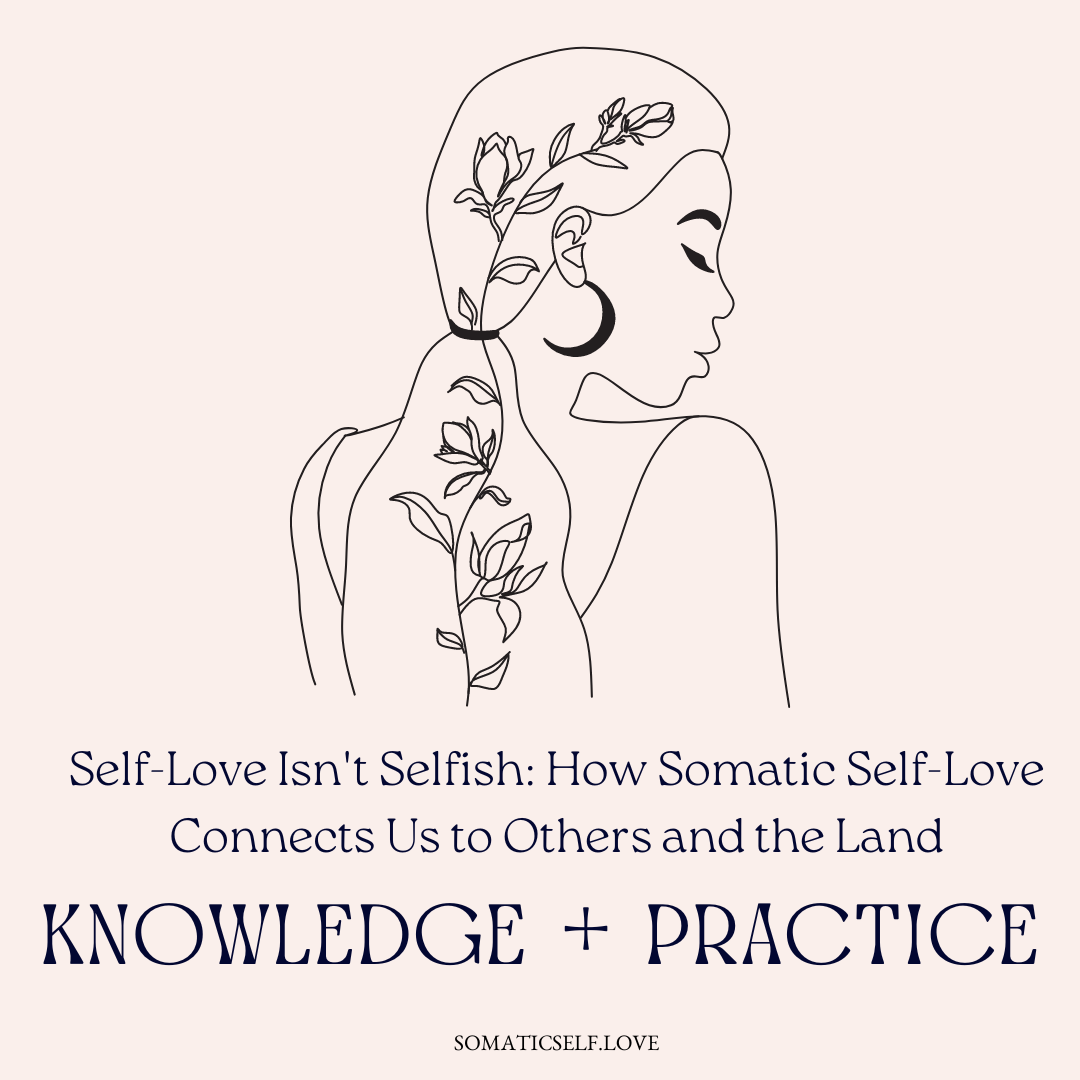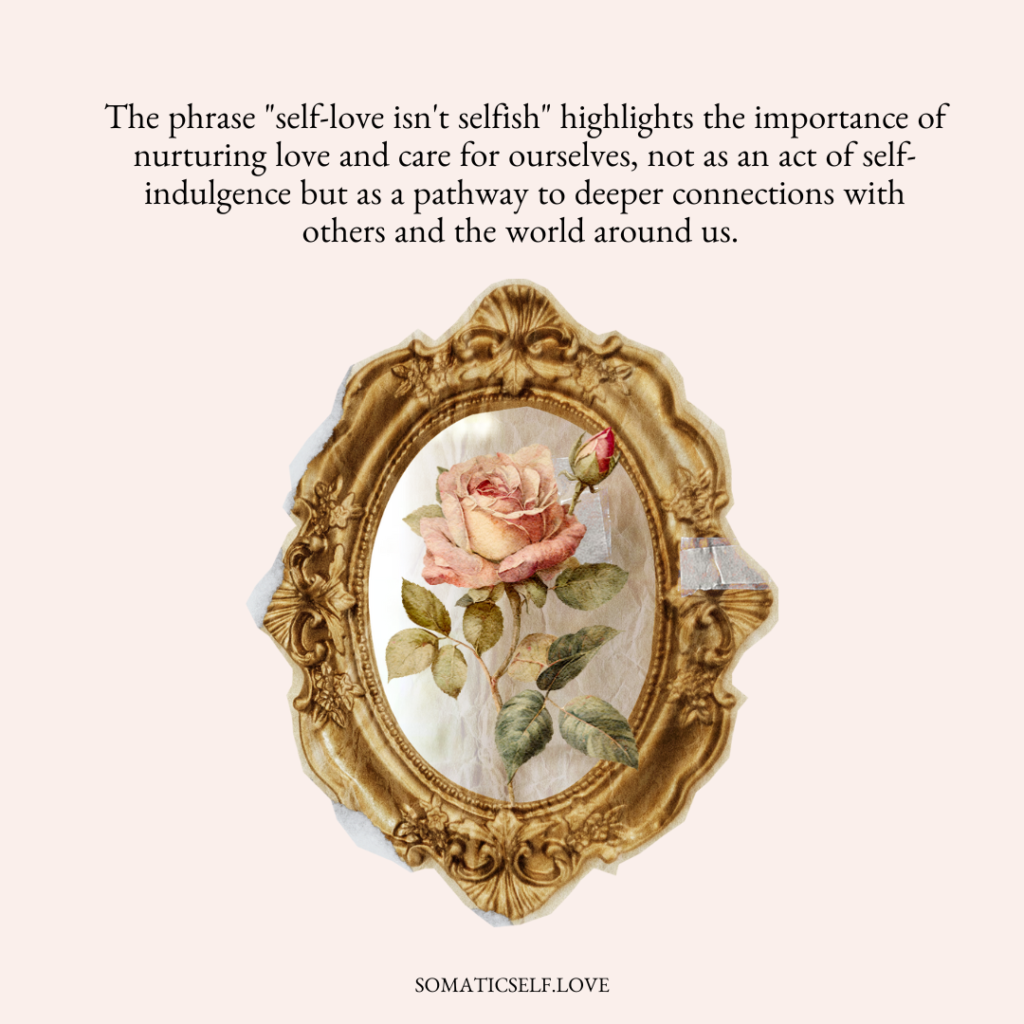Self-Love Isn’t Selfish: How Somatic Self-Love Connects Us to Others and the Land

“Self-love isn’t selfish.” We’ve all heard this phrase, but what does it truly mean, and how does it impact our connections with others and the world around us? In this blog post, we’ll explore the concept of somatic self-love, how it connects us to other people and the land, and its relationship with our nervous system, as explained by the polyvagal theory.
What is Somatic Self-Love?
Somatic self-love is the practice of experiencing love for ourselves on a bodily level. By cultivating a deep sense of self-compassion and acceptance, we can promote feelings of safety, relaxation, and connection within our bodies. This practice not only benefits our mental and emotional well-being but also has the potential to enhance our relationships and foster a deeper connection to the natural world.
The Polyvagal Theory and Connection
The polyvagal theory, developed by Dr. Stephen Porges, offers a framework for understanding the link between our autonomic nervous system, social behaviors, and experiences of connection. The theory focuses on the role of the vagus nerve, which has two branches: the ventral vagal complex (VVC) and the dorsal vagal complex (DVC). These branches serve different functions in relation to our social engagement and stress responses.
When we practice somatic self-love, we engage the ventral vagal branch, which is associated with the “social engagement system.” This system helps us feel safe, connected, and open to social interactions. By cultivating somatic self-love, we can activate the ventral vagal pathway, promoting feelings of safety and relaxation, which in turn can make us more open to connecting with others.

Connecting to Others
The idea that “self-love isn’t selfish” emphasizes that when we care for and love ourselves, we are better equipped to care for and love others. This is evident in the way somatic self-love activates our social engagement system through the ventral vagal pathway. When we feel safe and relaxed, we are more likely to be present and receptive in our interactions with others, leading to stronger, more fulfilling relationships.
Connecting to the Land
Our connection to the land can also be fostered through somatic self-love, as our bodies inherently respond to the natural environment. When we practice self-love and feel safe and grounded in our bodies, we can be more present and attuned to the land around us. This connection can foster a sense of belonging and a deeper appreciation for the natural world, which can further enhance our well-being and promote ecological awareness and care.
Conclusion: Self-Love as a Pathway to Connection
The phrase “self-love isn’t selfish” highlights the importance of nurturing love and care for ourselves, not as an act of self-indulgence but as a pathway to deeper connections with others and the world around us. By practicing somatic self-love, we can engage our social engagement system through the polyvagal theory, promoting feelings of safety, relaxation, and connection. This process can lead to more fulfilling relationships, a deeper sense of belonging to the natural world, and an increased commitment to ecological stewardship. So, go ahead and practice self-love—it’s not just for you, it’s for all of us.

A Body-Based Practice to Explore Somatic Self-Love and Connection
This body-based practice combines mindfulness, self-compassion, and movement to help you explore somatic self-love and connection with yourself, others, and the land. Please remember to listen to your body, and adapt or modify the practice as needed to suit your comfort and well-being.
Preparation
- Find a quiet, comfortable space where you will not be disturbed. It can be indoors or outdoors, but ensure that you have enough room to move freely.
- Wear comfortable clothing that allows for ease of movement.
- Take a moment to ground yourself by taking a few deep breaths, inhaling through your nose and exhaling through your mouth.
Step 1: Self-Compassion
- Begin by finding a comfortable standing position with your feet hip-width apart.
- Place one hand on your heart and the other on your belly.
- Close your eyes and take a few deep breaths, focusing on the sensation of your hands on your body.
- Silently repeat the following phrases to yourself: “May I be kind to myself. May I be safe. May I be healthy. May I live with ease.”
Step 2: Grounding and Connecting to the Land
- Slowly shift your awareness to your feet, feeling the connection between your feet and the ground beneath you.
- Imagine roots extending from your feet deep into the earth, anchoring you and providing a sense of stability and connection to the land.
- Take a few moments to breathe and visualize this connection, allowing yourself to feel supported and nourished by the earth.
Step 3: Movement and Self-Love
- Begin to gently sway your body from side to side, moving your arms and shoulders, and allowing your hands to leave your heart and belly.
- Let your movements become a form of self-expression and self-love, allowing your body to move freely and spontaneously.
- As you move, silently repeat the following phrases to yourself: “I love and accept myself just as I am. I am worthy of love and connection.”
Step 4: Expanding Connection
- Gradually let your movements become more expansive, reaching out with your arms and opening your chest, as if inviting others and the world around you into your experience of self-love.
- As you move, silently repeat the following phrases to yourself: “May I be connected to others. May I be connected to the land. May we all experience love and connection.”
Step 5: Integration and Closing
- Slowly bring your movements to a stop and return to a standing position with your feet hip-width apart.
- Place one hand on your heart and the other on your belly once again, and take a few deep breaths, allowing the sensations of love and connection to settle within your body.
- When you feel ready, open your eyes and take a moment to acknowledge the experience you just had, carrying the feelings of self-love and connection with you into your everyday life.
By practicing this body-based exercise regularly, you can cultivate somatic self-love and deepen your connection with yourself, others, and the land around you. Remember that self-love isn’t selfish — it’s a pathway to connection, compassion, and a greater sense of belonging in the world.